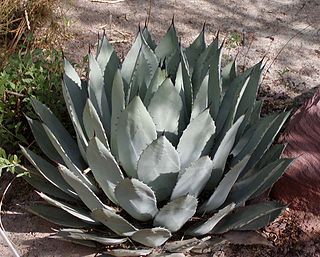
The Sonoran Desert is a desert in North America and ecoregion that covers the northwestern Mexican states of Sonora, Baja California, and Baja California Sur, as well as part of the southwestern United States. It is the hottest desert in both Mexico and the United States. It has an area of 260,000 square kilometers (100,000 sq mi).

Liriope is a genus of low, grass-like flowering plants from East and Southeast Asia.

Brodiaea, also known by the common name cluster-lilies, is a monocot genus of flowering plants.

Penstemon palmeri, known by the common name Palmer's penstemon, is a species of perennial flowering plant in the genus Penstemon that is notable for its showy, rounded flowers, and for being one of the few scented penstemons. The plant, in the family Plantaginaceae, is named after the botanist Edward Palmer.

The Yuma Desert is a lower-elevation section of the Sonoran Desert in the southwestern United States and the northwest of Mexico. It lies in the Salton basin. The desert contains areas of sparse vegetation and has notable areas of sand dunes. With an average rainfall less than 8 inches (200 mm) each year, it is among the harshest deserts in North America. Human presence is sparse throughout, the largest city being Yuma, Arizona, on the Colorado River and the border of California.

Tetracoccus is a plant genus under the family Picrodendraceae. Shrubby-spurge is a common name for plants in this genus. They are dioecious, often hairy shrubs.

Dasylirion wheeleri is a species of flowering plant in the asparagus family (Asparagaceae), native to arid environments of northern Mexico and the southwestern United States.

Asparagaceae, known as the asparagus family, is a family of flowering plants, placed in the order Asparagales of the monocots. The family name is based on the edible garden asparagus, Asparagus officinalis. This family includes both common garden plants as well as common houseplants. The garden plants include asparagus, yucca, bluebell, and hosta, and the houseplants include snake plant, corn cane, spider plant, and plumosus fern.

Hesperocallis is a genus of flowering plants that includes a single species, Hesperocallis undulata, known as the desert lily or ajo lily.

Doryanthes is the sole genus in the flowering plant family Doryanthaceae. The genus consists of two species, D. excelsa and D. palmeri, both endemic natives of the coast of Eastern Australia. Doryanthaceae is part of the order Asparagales.

Phacelia campanularia is a species of flowering plant in the borage family, Boraginaceae, known by the common names desertbells, desert bluebells, California-bluebell, desert scorpionweed, and desert Canterbury bells. Its true native range is within the borders of California, in the Mojave and Sonoran Deserts, but it is commonly cultivated as an ornamental plant and it can be found growing elsewhere as an introduced species.

Leucocrinum montanum, commonly known as the sand lily, common starlily or mountain lily, is the only species in the monotypic genus Leucocrinum, placed in the family Asparagaceae, and subfamily Agavoideae. It is native to the western United States, primarily in the Rocky Mountains and the Great Basin.

Olneya tesota is a perennial flowering tree of the family Fabaceae, legumes, which is commonly known as ironwood, desert ironwood, or palo fierro in Spanish. It is the only species in the monotypic genus Olneya. This tree is part of the western Sonoran Desert complex in the Southwestern United States.

Agave is a genus of monocots native to the hot and arid regions of the Americas and the Caribbean, although some Agave species are also native to tropical areas of North America, such as Mexico. The genus is primarily known for its succulent and xerophytic species that typically form large rosettes of strong, fleshy leaves. Agave now includes species formerly placed in a number of other genera, such as Manfreda, ×Mangave, Polianthes and Prochnyanthes.

Schoenolirion, rush-lily or sunnybell, is a genus of three recognized species of flowering plants, all endemic to the southeastern United States. In the APG III classification system, the genus is placed in the family Asparagaceae, subfamily Agavoideae.
Dandya is a genus of about four species of flowering plants, all endemic to Mexico. In the APG III classification system, it is placed in the asparagus family, and the cluster lily subfamily.
- Dandya balsensisA.R.López-Ferrari & Espejo - central and southern Mexico
- Dandya hannibaliiL.W.Lenz - Michoacán
- Dandya purpusii(Brandegee) H.E.Moore - Coahuila
- Dandya thadhowardiiL.W.Lenz - Michoacán, Guerrero

Agave palmeri is an especially large member of the genus Agave, in the family Asparagaceae.
Hesperelaea is a plant genus with only one species, probably now extinct. Hesperelaea palmeri was found only on Guadalupe Island, a small island in the Pacific Ocean, part of the Mexican state of Baja California, about 400 km (250 mi) southwest of Ensenada. The last collection of the plant on the island was in 1875, so the species and the genus must now be presumed extinct. An intensive search for the plant in 2000 was unsuccessful.
Triteleia lemmoniae, common names Oak Creek triteleia, Lemmon's star or Oak Creek triplet lily, is a plant species now classed in the family Asparagaceae, although older classifications would have regarded it part of the Liliaceae.
















